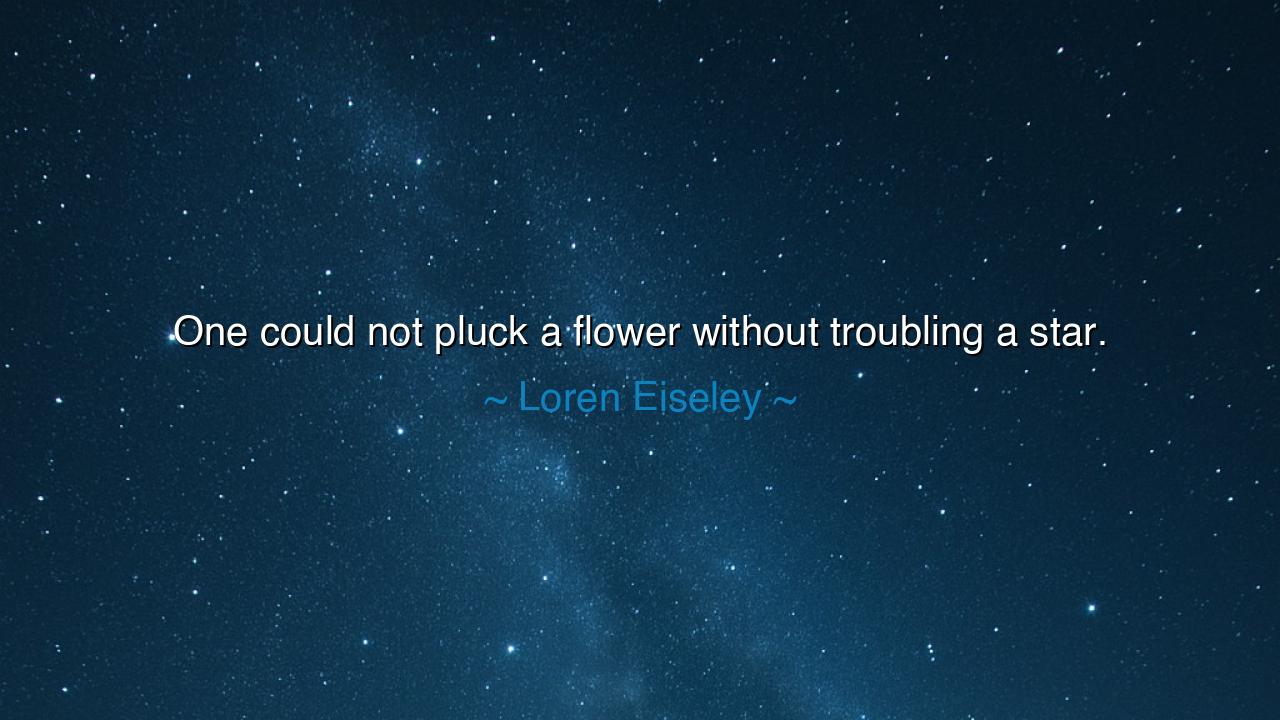
One could not pluck a flower without troubling a star.






Hear, O children of eternity, the words of Loren Eiseley, who proclaimed: “One could not pluck a flower without troubling a star.” In this image, luminous and profound, he reminds us of the hidden web that binds all things. Nothing stands alone; nothing exists in isolation. The flower in the meadow is not merely a thing of petals and fragrance—it is tied to the soil beneath, the rain above, the sun across the heavens, and even the distant stars that shaped the elements of its being. To disturb the smallest part of creation is to touch the whole, for all life is interwoven in the grand tapestry of the cosmos.
The origin of this thought rests in Eiseley’s life as both scientist and poet. He was a naturalist who saw the earth with reverence, perceiving not only its mechanics but its mysteries. His words echo the wisdom of ancient philosophers who spoke of the cosmos as one living body, where each part affects the whole. The flower may appear fragile and insignificant, yet it is linked through roots, light, and matter to the farthest reaches of the universe. To touch it is to awaken a chain of consequence, a ripple that extends to infinity.
Consider the story of the butterfly effect, first hinted at by mathematicians and later understood by scientists of chaos theory. A butterfly’s wings in one corner of the world may, through subtle chains of cause and effect, influence a storm across the seas. In the same way, to pluck a flower is not a solitary act. It is bound to the bee that sought its nectar, to the seed that might have grown, to the soil that nourished it, to the carbon and starlight that formed its atoms. To trouble the flower is, in some sense, to trouble the star.
History, too, shows us this truth in human affairs. When Archduke Franz Ferdinand was assassinated in Sarajevo, it seemed at first a small act, the death of one man. Yet that single deed, like the plucking of a flower, set in motion the First World War, reshaping nations and destinies across the globe. One life lost, and the entire order of the world trembled. Such is the law of interconnection: the smallest disturbance reverberates through the greatest structures.
The meaning, then, is both humbling and exalting. It humbles, because it reminds us that our actions, however small, are never without consequence. We are not isolated wanderers, but threads in the great fabric of existence. It exalts, because it shows us that even the smallest gesture carries weight and power. To speak a kind word, to plant a seed, to show mercy—these too ripple outward, touching unseen lives, reaching even to the stars.
Thus, the lesson for you, listener, is clear: act with reverence. Do not despise the small, nor dismiss the humble. The flower you pluck, the word you speak, the choice you make—all are connected to the whole of being. Live, therefore, with care, with mindfulness, with honor for the bonds that link you to all creation. In this way, your life will not disrupt the harmony of the cosmos, but will add to its beauty.
Practical actions follow from this wisdom. Before you act, pause and consider the ripples. Treat nature as sacred, for its smallest parts are bound to the stars. Treat others with dignity, for their fate and yours are entwined. Choose to plant rather than destroy, to heal rather than wound, to nurture rather than exploit. For in doing so, you not only protect the flower, but honor the star.
So remember the teaching of Eiseley: “One could not pluck a flower without troubling a star.” Live as one who knows the vast web of being, who acts with reverence for both the smallest blossom and the farthest light. In this way, your life will be woven into the eternal harmony, and your steps will echo like music across the stars.






AAdministratorAdministrator
Welcome, honored guests. Please leave a comment, we will respond soon